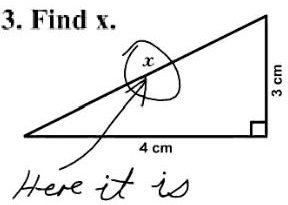Ratio Math Practice: Definition of a Ratio & Sample Problems
What is a Ratio?
A ratio expresses a relationship between two (or more) numbers of the same type; as such, it is simply two numbers with no units. A ratio gives us an easy way to compare two numbers. For example, a tv or monitor will generally have a ratio of 4:3 (for an older display) or 16:9 (for a widescreen display). This means that a widescreen monitor has 16 horizontal units for every 9 vertical units (or, more simply stated, 16 units of width for every 9 units of height). Knowing how to find a ratio in math allows us to make important comparisons in everyday life.
In geometry, we say that two figures (usually triangles) are proportional if their sides are in the same ratio to each other. For example, one right triangle could have sides with lengths of 3, 4, and 5 inches, while another has sides with 6, 8, and 10 feet. Because both triangles are in a 3:4:5 ratio, they are proportional; they have the same shape.
Sample Problems
Let’s try a few sample problems; the answers will be in the next section.
-
John is considering buying one of two houses. The first house is 6 miles away from his job, and the second house is 9 miles away from his job. What is the ratio of the two distances, in lowest terms?
-
Mary made $12 per hour at her old job. If she got a raise when she moved to her new job and now makes $15 per hour, what is the ratio of her new salary to her old salary?
-
A right triangle has three sides with lengths x, y, and z, such that side z is the hypotenuse (the side opposite the right angle) and x2 + y2 = z2. Let triangle A have x=3 and y=4. If the ratio of triangle A to similar triangle B is 1:4, how long is the hypotenuse on triangle B?
Answers
Do you understand how to find a ratio? Here are the answers to the questions above.
-
As the first distance is 6 miles and the second is 9 miles, the units cancel out and we have a ratio of six to nine, generally expressed as 6:9. Six and nine are both divisible by three, so we can reduce this to the simpler 2:3 ratio.
-
The ratio of her new salary to her old salary is 15:12 (the units, dollars, cancel out); these numbers are each divisible by three, so this reduces to 5:4. Expressed as a percentage, Mary received a 3/12 = 1/4 = 25% raise!
-
This is a tricky one! As the ratio is 1:4, we know that each side in triangle B is four times as long as the corresponding side in triangle A. As A is a right triangle, we calculate that 32 + 42 = 9 + 16 = 25 = 52, so z is 5. Five times four is twenty, means that the hypotenuse on triangle B must have length 20 (and the other two sides have lengths 12 and 16). 122 + 162 = 144 + 256 = 400, which is the square of 20, so the math checks out.
References
- William Springer previously taught middle school mathematics; he now does math research at Colorado State University.
- Image has been granted for use in the public domain.
This post is part of the series: Mathematical Fundamentals
What are the basic rules that you need to know to make sense of arithmetic and algebra?
